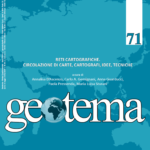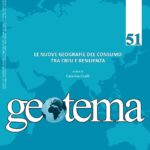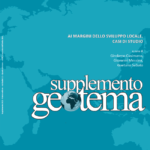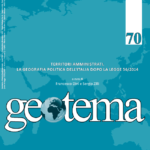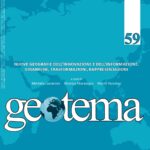Maria Prezioso
Researching in geography, it is possible to match science, theory and practice of the territorial development
Sommario: Per contrastare la crisi, le politiche e le direttive europee, nazionali e regionali sono state incrementate, influenzando e modificando i contenuti della pianifi cazione economico-territoriale, per includere obiettivi prioritari comuni, come coesione, sostenibilità, competitività, policentrismo, ecc. Dal 1995 al 2006, la ricerca geografi ca italiana ha sviluppato un nuovo approccio teorico-metodologico e una strumentazione GIS in grado di valutare ex ante la sensibilità territoriale di politiche e programmi, defi nita Sustainable Territorial environmental/ economic Management Methodological Approach (STeMA). Dopo un periodo di sperimentazione e di revisione critica, questo approccio teorico è stato discusso per sostenere diverse ricerche europee e applicato ai programmi LIFE, ESPON, CADSIS, e alla Carta di Lipsia e Europa 2020 dal punto di vista geografico, riducendo i rischi di impatto e gli effetti (positivi o negativi) sul capitale iniziale territoriale (capacità o sensibilità). Il contributo, ripercorre le questioni teoriche alla base di STeMA, si concentra sugli aspetti scientifi ci relativi alla Valutazione d’Impatto Territoriale (TIA) e alla Valutazione Ambientale Strategia (VAS) della politica regionale e sulle scelte di pianifi cazione regionale che la rendono coesa, sussidiaria, competitiva in sostenibilità alle diverse scale NUTS 1, 2, 3.
Abstract: By the access of new countries, European policies and directives are increased as well as national and regional ones, influencing territorial and spatial planning and modifying it for including common priority objective as cohesion, sustainability, competiveness, polycentrism, etc. From 1995 to 2003, the Italian geographical research has developed a new methodological theory able to assess the territorial sensitivity of policies and programmes; and since 2004 it includes the competitiveness and cohesion assessment (Prezioso, 1995; 2003; 2006; 2007; 2008; 2009, 2010). After an experimental period of texiting and critical review, this theoretical approach, called Sustainable Territorial environmental/economic Management Methodological Approach (STeMA), and its tool GIS, were discussed for supporting several European applied researches onto LIFE, ESPON, CADSIS, Cohesion, Leipzing Charter programmes. The paper goes back over the STeMA theoretical questions, focusing on scientifi c questions relative to the Territorial Impact Assessment (TIA) and the Strategy Environmental Assessment (SEA) of regional policy making and European policy inclusion in planning choices for obtaining a cohesive and competitive development in sustainability in different target areas individuated at NUTs 1, 2, 3. In order to defi ne this IV generation methodological protocol and its selected use of common scientifi c indicators, some words will be spent looking at the territorial diversity and testing it from the territorial point of view. The latter can be considered as the initial territorial capital or capacity building or sensitivity by which assessing impacts and effects (positive or negative) of integrated EU policies, to do endogenous corrections. Finally, in order to reduce these risks, the paper arranges those rules (governance) and those procedures/laws (compliance) to which the territorial government is due, transferring new geographical address in planning culture, making subsidiary orientations, procedures, standards; they transform interests of investors, enterprise systems, interest-taken, citizen and citizenships on the “best practise” way.
Keywords: Research in Geography, Competitiveness, Cohesion, Sustainability.
GEOTEMA_42_15_Prezioso


